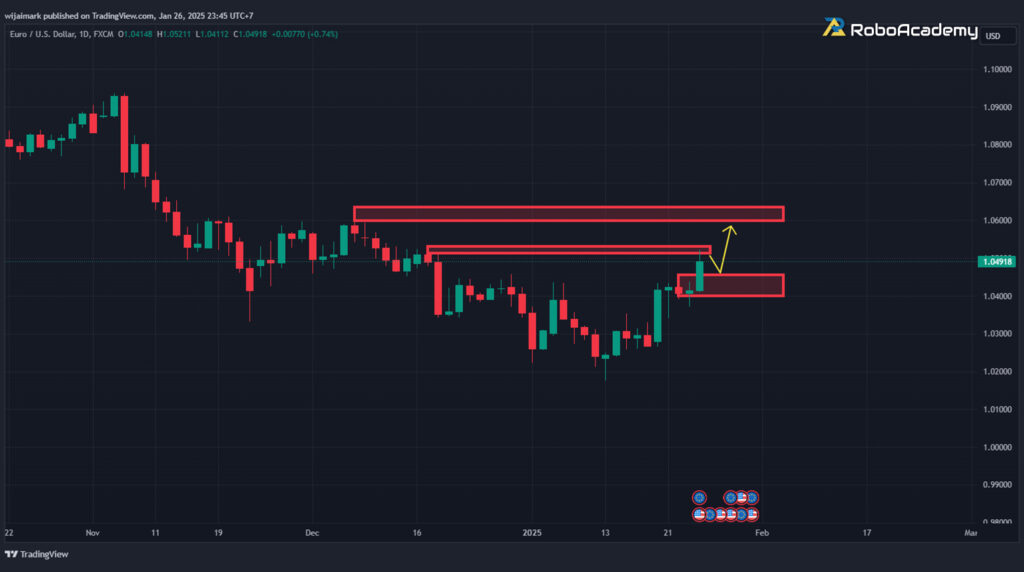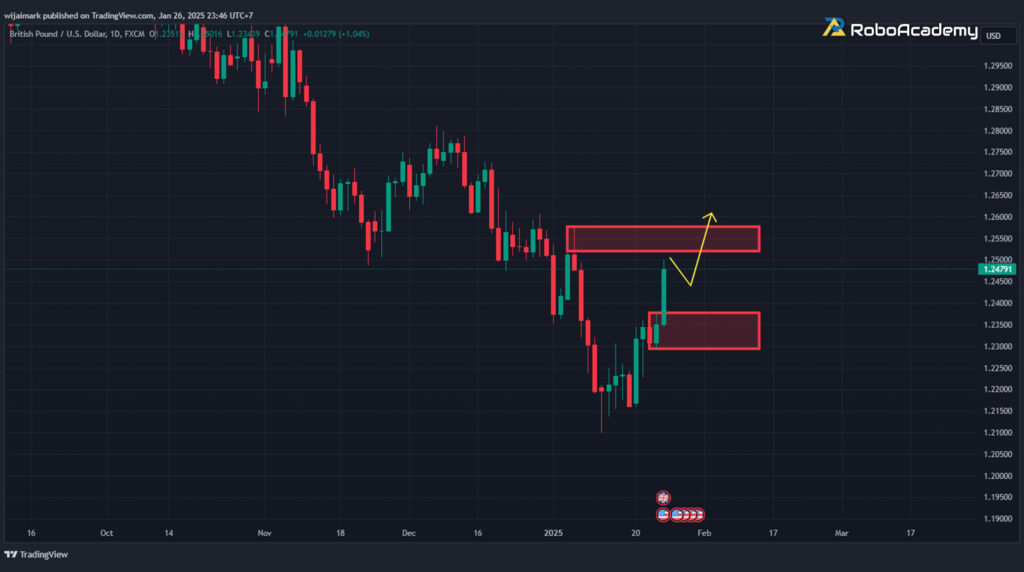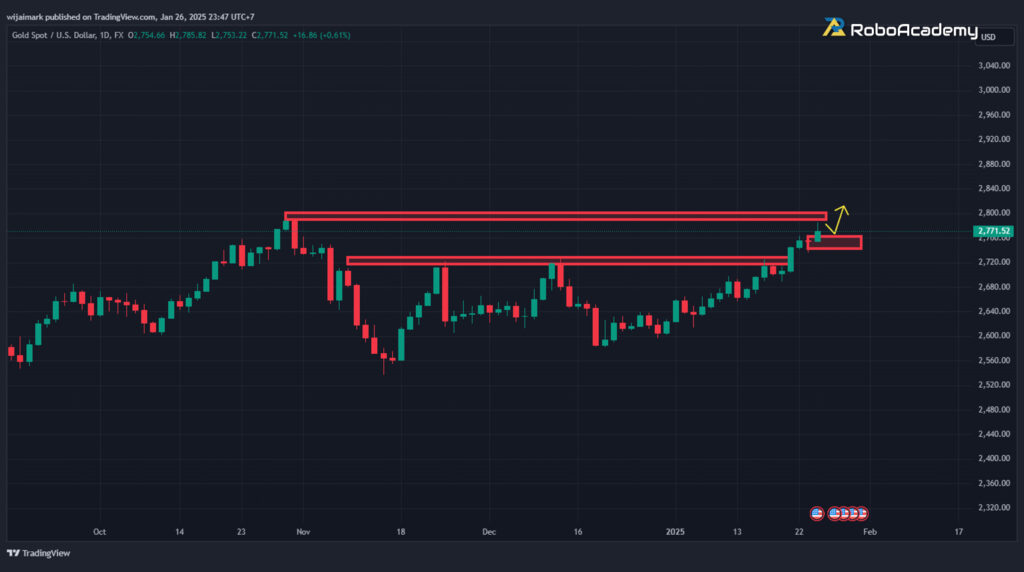Fundamental & Technical Analysis by Coach Mark RoboAcademy during 27 – 31 January 2025
Hello everyone, welcome to the weekly analysis of currency pairs EUR/USD, GBP/USD, and XAU/USD for the last week of January, from 27 – 31 January 2025.
EUR/USD, “Euro vs US Dollar”

Fundamental Analysis
Significant Economic Events Impacting EUR/USD This Week:
European Economic Data:
- Eurozone Consumer Confidence Index (27 January): If the numbers improve, it may reflect increased economic confidence, which would support the euro. However, if the numbers come in lower than expected, it could put pressure on the euro against the dollar.
- Germany CPI (29 January): As Germany is the largest economy in the Eurozone, higher-than-expected inflation figures could indicate persistent price pressures and increase the likelihood of the European Central Bank (ECB) adopting stricter monetary policies, which may support the euro.
- Eurozone CPI (31 January): If the numbers come in higher than expected, it could signal that inflationary pressures remain elevated, potentially prompting the ECB to maintain tight monetary policies or delay interest rate cuts, which would have a positive impact on the euro.
U.S. Economic Data:
- U.S. Consumer Confidence Index (28 January): If U.S. consumer confidence figures exceed expectations, it could support the dollar and put pressure on the EUR/USD currency pair.
- FOMC Meeting (29 January): Investors will closely watch the FOMC’s statement. If there are signals to keep or raise interest rates, it could impact the direction of the dollar.
- U.S. Initial Jobless Claims (30 January): Lower-than-expected jobless claims could support the dollar and put pressure on the EUR/USD currency pair.
- U.S. Preliminary GDP (30 January): If GDP figures come in better than expected, it could support the dollar and put pressure on the euro.
- U.S. Employment Cost Index (31 January): This index reflects changes in wages. If it rises, it could support the dollar and put pressure on the EUR/USD currency pair.
Technical Analysis
The price has rebounded from the support level as per the plan set last week, which anticipated a possible reversal.
At this point, it is recommended to wait for a slight pullback in the 1.04500-1.04000 zone before entering a Buy position. If the price moves below the 1.04000 level, it would be prudent to delay the buy entry and observe the price behavior before making any decisions, as there is still a possibility that the price may continue to decline.
GBP/USD, “Great Britain Pound vs US Dollar”

Fundamental Analysis
Significant Economic Events Impacting GBP/USD This Week:
U.K. Economic Data:
- U.K. Nationwide House Price Index (27 January): If the figures come in higher than expected, it could indicate the strength of the U.K. housing market and have a positive impact on the pound.
- U.K. CPI (28 January): Higher-than-expected inflation figures could increase pressure on the Bank of England (BoE) to adopt tighter monetary policies, which would support the pound.
- U.K. Mortgage Approvals (29 January): This figure reflects the strength of the housing sector. If it exceeds expectations, it could boost confidence and support the pound.
- U.K. PMI (31 January): If the PMI figures come in stronger than expected, it could signal a strong economic outlook for the U.K. and be a positive factor for the pound.
U.S. Economic Data:
- U.S. Consumer Confidence Index (28 January): If the figures come in strong, it could support the U.S. dollar and put pressure on the GBP/USD currency pair.
- FOMC Meeting (29 January): Investors will closely monitor the FOMC’s statement. If there are signals for further interest rate hikes, it could negatively impact GBP/USD.
- U.S. Initial Jobless Claims (30 January): If the numbers come in lower than expected, it could be a positive factor for the U.S. dollar and put pressure on GBP/USD.
- U.S. Preliminary GDP (30 January): If the GDP figures come in better than expected, it could support the U.S. dollar and increase pressure on the pound.
- U.S. Employment Cost Index (31 January): If the numbers rise, it could be positive for the U.S. dollar and put pressure on GBP/USD.
Technical Analysis
The price has increased, and the resistance was tested at 1.25300 before pulling back slightly, indicating the presence of selling pressure at the resistance zone. The recommended strategy is to buy, with entry points in the 1.24400-1.24000 zone, which is a key support area.
However, if the price falls below the 1.23000 level, it is advised to pause and observe the price behavior before making a decision, as there is a chance that the upward trend could start to reverse, or it may be necessary to wait for the formation of a new base before another upward move.
XAU/USD, “Gold vs US Dollar”

Fundamental Analysis
Significant Economic Events Impacting XAU/USD This Week:
Economic Data Related to Gold:
- Eurozone Consumer Confidence Index (27 January): If the number comes in strong, it could reduce demand for gold as a safe-haven asset. However, if it comes in lower than expected, it may support gold prices.
- U.S. Consumer Confidence Index (28 January): Strong consumer confidence may boost the dollar and put pressure on gold prices.
- Germany CPI (29 January): If inflation numbers come in high, it could support demand for gold as a safe-haven asset.
- FOMC Meeting (29 January): If the FOMC signals further interest rate hikes, it may have a negative impact on gold prices, as higher interest rates often reduce gold’s appeal.
- U.S. Initial Jobless Claims (30 January): A stronger labor market could boost the dollar and put pressure on gold prices.
- U.S. Preliminary GDP (30 January): If U.S. GDP comes in stronger than expected, it could negatively affect gold prices, as investors may shift toward riskier assets.
- Eurozone CPI (31 January): High inflation numbers could increase demand for gold as a hedge against inflation.
- U.S. Employment Cost Index (31 January): If employment costs rise, it may strengthen the dollar and put pressure on gold prices.
Technical Analysis
The price has been continuously rising and, in the past week, has successfully broken the previous 3 Equal High resistance levels. Currently, the price is testing the 2790-2800 resistance zone, approaching a potential breakout to make a new All-Time High (ATH). If the price pulls back slightly to the 2750-2740 zone, this could be an ideal opportunity to enter a Buy position and aim for further upward movement.
However, it’s important to keep an eye on news and events throughout the week, as they may lead to a sharp decline. If the price breaks below the 2735 support level, it would be prudent to wait and observe the market’s behavior before making further decisions.
Disclaimer: This article is solely an analysis from the coach at RoboAcademy and is not intended as investment advice in any way. Investing is risky. Investors should study the information before making investment decisions.


